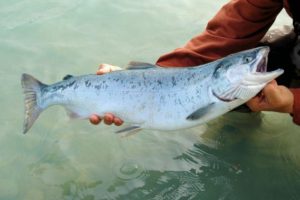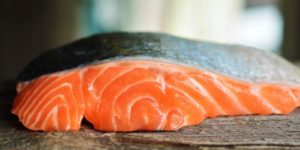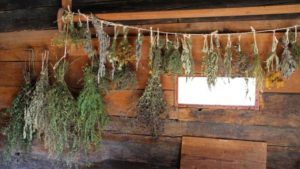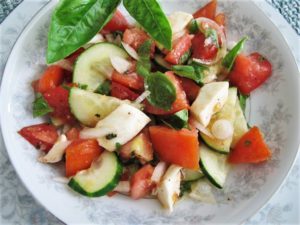Herbed Salmon
The Good
Most of us are familiar with the benefits of including salmon in our diets. It’s an excellent source of protein, Vitamins B12, B3, B6, D, Omega-3 fats, and the mineral selenium. Other nutrients include phosphorus, iodine, choline, pantothenic acid, and some potassium, iron, and zinc.
Research indicates that salmon helps ease the inflammatory process (through bioactive peptides—amino acids—affecting joints, brain, and heart tissues), and plays a part in preventing macular degeneration and certain kinds of cancer. The Omega-3 fats it contains are the ones that are most helpful, namely DHA and EPA.
The Bad
Every now and then, I come across someone who recommends not consuming it. The stated cause for concern is the level of pollutants found in salmon. Polychlorinated biphenyls (PCB’s), no longer produced but still circulating in the environment, and other contaminants are thought to contribute to some types of cancer.
After reading over a dozen credible websites comparing wild-caught salmon to farm-raised salmon and their positions on PCB’s, I decided to summarize and offer this: Wild salmon is many times lower in PCB’s than farm-raised salmon. And, many studies show no correlation between salmon consumption and an increase in cancer.
Consistency among the websites is as scattered as confetti in the wind! Even the U.S. Food and Drug Administration and the Environmental Protection Agency don’t agree on the acceptable level of PCB’s in our food sources, last time I checked.
Farmed salmon originating in Washington State and Chile have less contamination than farmed salmon coming from Europe. Wild-caught salmon from Alaska has lower levels than any other sources. Because PCB’s accumulate in fatty tissues, it is often recommended to trim off excess fat and the skin.
As consumers, we have access to both farm-raised and wild-caught salmon. So I purchase only wild-caught salmon from Alaska. When it is available, I buy a larger fillet, rinse it, place serving-size pieces into plastic bags, and freeze it. Admittedly, the texture is much better when cooked fresh, and that’s how I serve it to others.
And the Not-So-Pretty
There’s another significant difference between salmon from farmed sources and salmon that’s wild-caught. The healthier Omega-3 polyunsaturated fat is higher in wild salmon, and the less healthy Omega-6 is higher in farmed salmon. You want to consume a higher Omega-3 level compared to Omega-6, even though we do need a smaller amount of Omega-6 fat in our diets. So, wild salmon wins again.
Even though there’s some scary, and dubious, information on a few websites I visited, the consensus remains on the “we recommend a moderate consumption of wild-caught salmon” side of the argument. One site, among my favorites for science-based nutritional information, strongly supports a plant-based diet and therefore recommends against eating any salmon.
I like this fish too much to eliminate it from my diet, and we eat other kinds of fish as well. For its heart-healthy benefits, I will continue to prepare it every week or two. Most of the websites I visited recommended consuming salmon once or twice a month. Including salmon in your diet is your choice, and the information is out there for you to decide.
How to Prepare Herbed Salmon
Ingredients
This is for 2 servings.
- 8 to 12 ounces fresh salmon fillet, rinsed
- 1 quick spritz non-stick cooking spray, optional
- several leaves of ‘Siam Queen’ Thai basil, coarsely chopped, or 2 tsp. dried (more or less according to taste)
- 1½-2 tsp. fresh dill weed, or 1 tsp. dried (or to taste)
- Salt to taste
- 2 to 3 Tbsp. butter
The Process
- Preheat oven to 400°F.
- Spray a baking dish with non-stick spray, if you choose.
- Lay the salmon, skin side down, if you choose to keep it on, on top of a small amount of butter in the dish. If fish is thick, score the thick part with a knife to cook it faster.
- Press the basil and dill onto the salmon. Fresh herbs are preferred, but these two herbs retain good flavor when dried.
- Place the rest of the butter, in pieces, on top of the fish.
- Bake hot 8 to 15 minutes, shorter or longer depending on thickness of the fish. Baste once or twice while cooking to distribute those delicious flavors.
- It’s done when the flesh flakes. Monitor closely because fish will be dry if overcooked.
- Sometimes I broil it for the last minute to “caramelize” the points.
- No need to turn it unless it’s very thick.
- Give it a dash of salt after removing it from the oven.
- Serve with the herbed butter in the pan. I don’t use lemon, which would overpower the flavors of the herbs.
If you prefer, fish can be grilled. Avoid very high temperatures or burning the fish, as this can affect nutrients and produce free radicals, which you don’t want.
It’s that easy! A little experimentation in the kitchen can result in fabulous meals for you and your family, ones you’ll go back to regularly. When I started offering Thai basil for sale at farmers’ markets, I had to figure out a way to use it in cooking. I never was fond of the licorice flavor of Thai basil. So I tried it in a couple of dishes and salads…nothing clicked.
Then, I thought, since I like salmon with dill, let’s try Thai basil with fish. Now, that’s the only way I make salmon! Over the years, I’ve tried other varieties of Thai basil and sweet basils, but prefer the richly-flavored ‘Siam Queen’ Thai basil, an All-America Selections Winner. Even though it has a powerful fragrance fresh, it mellows beautifully during cooking. This herb loves our hot summers, and, so far this year, we have been spared that dreaded basil disease, Basil Downy Mildew.
How to Dry Basil
When the plant starts to produce flowers, I cut back the flowering stems to a few inches above the soil, discard the flowers, rinse leaves and pat dry.
Remove any leaves that lack good color; pale leaves or very old ones are off-flavor or more bitter. Basil is a fast-growing leafy herb that needs to be fertilized now and then to produce high quality foliage.
Lay the leafy stems on a dish lined with a paper towel, and keep at room temperature, out of direct sun. Turn them occasionally. When leaves are almost dry and beginning to curl, strip or snip them from the stems and place them back in the dish to dry thoroughly. Instead, you can remove all the good leaves from the stems at the start, placing them in a single thickness on the paper towel so they don’t mat together.
Another option is to hang small clusters of stems to dry. Gather the stems together with a rubber band, which will continue to hold the stems firmly as they shrink.
Microwaving or oven-drying herbs at very low heat is faster, but nutrients are destroyed, and, to me, the herbs always taste burned. I don’t recommend this practice.
Both Thai basil and dill retain very good flavor when dried. Use more, maybe twice as much, when using fresh herbs, which is my preference.
Storing Basil
Once they are crispy dry, store the whole leaves in a glass jar. The reason you don’t chop them up is that cut surfaces cause more of the flavor to dissipate. Be sure the leaves are dry; if there’s any moisture remaining, they will go moldy in storage. With one or two plants grown in the summer, I can harvest enough leaves to get us through the winter.
What’s for dinner at your place? After writing this, I think tonight we’ll have Herbed Salmon. And Tomato-Basil Salad, since I just picked 3 beautiful ‘Big Beef’ tomatoes from the garden.




